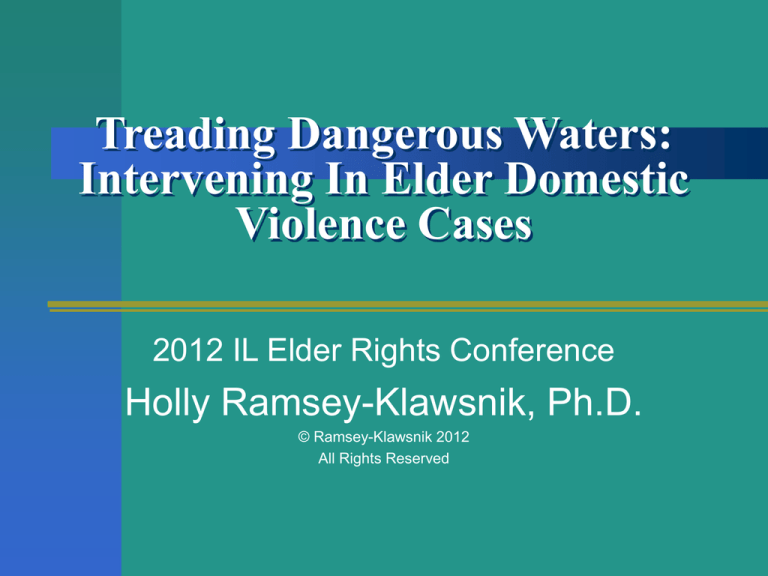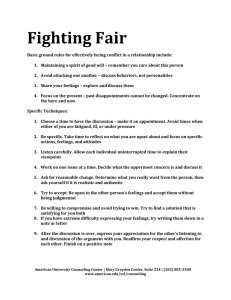
Treading Dangerous Waters:
Intervening In Elder Domestic
Violence Cases
2012 IL Elder Rights Conference
Holly Ramsey-Klawsnik, Ph.D.
© Ramsey-Klawsnik 2012
All Rights Reserved
Agenda
Common dynamics in Elder DV
Community and facility illustrative cases
Strategies for assisting victims
Pitfalls to avoid
Ramsey-Klawsnik Training
Materials
2
The Many Potential Pitfalls
68 y.o. Mrs. S., psychiatric disability,
mentioned marital problems to MD
MD inquired re: details
Long-term DV disclosed
MD reported & provided expert opinion
to APS, hospitalized Mrs. S.
Ramsey-Klawsnik Training
Materials
3
Mrs. S. con’t
As the case unfolded…
There are many junctures at which a
case can be mishandled to the
detriment of the victim
Ramsey-Klawsnik Training
Materials
4
Common Dynamics in LL IPV
Often long-term abuse
May be mutual attachment, dependency
Complex victim feelings
Abuser feels entitled to bully, control, use
Danger often high
Ramsey-Klawsnik Training
Materials
5
Socio-Cultural Factors
Social, cultural, gender, legal realities
during formative years of today’s elders
Very much affect older victims of today
Must be considered when attempting
investigation or intervention
Ramsey-Klawsnik Training
Materials
6
Child & Grandchild Perpetrators
Assault by offspring often causes
powerful ambivalence
Fear of perp arrest & other harm,
shame, responsibility for kin’s wrong,
attachment
Feelings complicate trauma response
and help-seeking
Ramsey-Klawsnik Training
Materials
7
Video Clip
Mother abused by adult son
From “A Mother Never Gives Up Hope”
by Terra Nova & NCALL
Ramsey-Klawsnik Training
Materials
8
Elder DV in Facilities
May occur in facilities during visits
May occur during outings
Staff may hear disclosure, witness
assault or evidence
Facility response & responsibilities
Ramsey-Klawsnik Training
Materials
9
Case: DV Signs Noticed
Woman with aphasia & paralysis
evidences fear of leaving w/ spouse
Facility response
APS response
Family response
Ramsey-Klawsnik Training
Materials
10
Case: DV Signs Observed
Upon return from outings aides
repeatedly observe abuse evidence
Facility response
APS response
Family response
Ramsey-Klawsnik Training
Materials
11
Helpful Response
Build rapport
Listen carefully
Offer safety options
Help victim consider options
Encourage use of effective strategies
Support victim’s choices
Follow legal mandates
Ramsey-Klawsnik Training
Materials
12
Strategies for Victim Assistance
Active listening
Crisis-intervention counseling
Problem-solving counseling
Referrals to other agencies, including
criminal justice
Ramsey-Klawsnik Training
Materials
13
Active Listening
Client feels heard & understood
Critical in all helping relationships
Foundation of all counseling skills
Ramsey-Klawsnik Training
Materials
14
Active Listening
Listen respectfully, completely to understand message
Watch non-verbal behavior to better understand
Demonstrate sincere interest client
Avoid placing attention elsewhere
Provide minimal encouragements to continue
Repeat key words
Ask questions after client’s presentation
Ramsey-Klawsnik Training
Materials
15
Case: Failure to Listen
Betty, 76 y.o., stroke, son lives with her
Son highly problematic, evidence of FE
APS worker offers money manager
Betty refuses
Worker documents: Betty wants son to
continue handling finances
Ramsey-Klawsnik Training
Materials
16
Crisis Intervention
Crisis - crucial situation, causes disequilibrium
Short-term intervention to help settle crisis
Goal - help client return to pre-crisis state
NOT solve long-term problems
Ramsey-Klawsnik Training
Materials
17
Crisis Symptoms
Strong, fluctuating emotions
Inability to function normally: think, eat, sleep
Overwhelming fear, worry, anxiety
Reduced problem-solving ability
Acting on impulse, poor decision-making
Inability to see a solution
Belief that things will never be normal
Ramsey-Klawsnik Training
Materials
18
Steps in Crisis Reduction
Encourage venting
Avoid joining crisis mind set
Actively listen
Focus on client’s reactions, thoughts, feelings
Provide emotional support
Validate
Normalize feelings and reactions
Gently correct cognitive distortions
Reframe to help see positives
Ramsey-Klawsnik Training
Materials
19
Steps con’t
Provide info re: options, resources
Help mobilize resources
Use problem-solving counseling
Ramsey-Klawsnik Training
Materials
20
Problem-Solving
Analyze problems with client
Help explore options for resolution
Ramsey-Klawsnik Training
Materials
21
Determine
Nature & scope of problem
Steps already taken & outcome
Ramsey-Klawsnik Training
Materials
22
Explore Options
Encourage client to suggest & consider options
Provide info re: options, resources
Anticipate likely & possible consequences
Empower client to make informed choices
Provide support while client implements
Ramsey-Klawsnik Training
Materials
23
Dynamics
Victimization » helplessness,hopelessness
Avoid joining client in these feelings
Model optimistic but realistic attitude
With support people explore options,
become hopeful
Improved outlook » energy & confidence
Ramsey-Klawsnik Training
Materials
24
Respect Self-Determination
• Avoid telling clients what to do
• People more likely to implement own choices
Ramsey-Klawsnik Training
Materials
25
Assisting Mr. R.
APS report - 82 yo Jose Rodriquez
Clinic filed: rectal bleeding, anal tears,
DV disclosure
Investigation revealed…
Mr. R’s ambivalent feelings
Intervention provided
Ramsey-Klawsnik Training
Materials
26
Tearing Down Strengths
Critical to avoid tearing down victim’s
strengths and defenses
Must be able to recognize the +
Build on these
Ramsey-Klawsnik Training
Materials
27
Case: Sibling Violence
Elderly, ill sisters reported to APS
Mutual physical violence
Both treated at hospital repeatedly
Police involved & reported
Mutual strong attachment
Ramsey-Klawsnik Training
Materials
28
Intervention Missed the Mark
Broke down resolve to improve
Worker failed to grasp clinical dynamics
Did not use problem-solving strategies
Ramsey-Klawsnik Training
Materials
29
Pitfalls to Avoid
Victim-blaming
Colluding with perpetrator
Expecting too much change too quickly
Telling victim how to solve problems
Tearing down strengths and defenses
Ramsey-Klawsnik Training
Materials
30
Our Language Matters
“We work with people who have family
problems”
Better…
Ramsey-Klawsnik Training
Materials
31
Do No Harm
Home visit to inv PA & EA by husband
of wife with Parkinson’s Disease
Investigator observes…
Investigator remarks…
Harm to victim and to case
Ramsey-Klawsnik Training
Materials
32
Summary
Worker behavior, statements,
attempted interventions carry much
potential to significantly help or harm
older DV victims
Importance of professional training, selfreflection and quality supervision
Ramsey-Klawsnik Training
Materials
33



